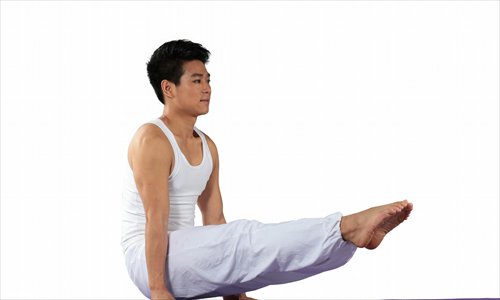HOME >> METRO BEIJING
Male posers
By Lin Kan Hsuan Source:Global Times Published: 2013-12-24 20:28:01

Yoga requires strength as well as flexibility. Photo: IC
Yoga today is a female domain. Around 80 percent of yoga practitioners in China are women, as are most yoga instructors. However, the traditional Indian discipline is gradually becoming a workout choice for men."I've taught yoga for five years in Beijing. A couple of years ago, all my male students were there because of their wives, but nowadays more men are aware of the advantages that yoga can offer," said He Yongxian, 26, a male teacher at Yogi Lotus Yoga in Xicheng district.
A graduate of the dance department at Tianjin University of Sport, He decided to become a professional yoga teacher in 2008. "At first, I preferred Anusara or Ashtanga yoga, which requires students to complete each posture quickly," He said. "But I found that yoga practitioners should not focus exclusively on the postures; the breathing technique and meditation are crucial as well."
When He realized this, he started practicing Iyengar yoga, which includes more deliberate muscle movements and the use of assistive devices. "When I started practicing Iyengar, I experienced a mental transformation from impatience to tranquility," he said.
Having visited Pune, India for intensive study this October, He said that the introduction of yoga to China involved misleading descriptions. "All the promotional material described yoga as beneficial for keeping fit and developing a slim figure, which undoubtedly attracted women," He explained. "Also, the elegance of yoga poses made women more willing to try it."
Yoga is often misunderstood to be an activity that only requires supple limbs. In fact, strength is essential to the practice. "Misconceptions have discouraged men from participating in an exercise that combines physical, mental and spiritual practices," said Zhang Hengfeng, 22, a male instructor at Fine Yoga in Chaoyang district.
"Men may think yoga emphasizes flexibility, which is perceived to be a physical trait more innate to women," Zhang said. To do so is to seriously overlook yoga's reliance on a sense of balance, physical coordination and so on, he said.
According to both He and Zhang, yogis (masters) are traditionally male. "In India, most yoga practitioners are men, who view the discipline as a means of expressing religious piety," said He. "Unlike China, there are segregated yoga classes for women there."
The most famous yogis, such as B.K.S. Iyengar and A.G. Mohan, are all men. When asked why, He responded that female yoga teachers' priorities tend to shift to their families after they get married and have children. "I can hardly think of any female yogis who returned to teaching after this transition period in their life."
Zhang is determined to make yoga his lifelong career, but he does understand why certain men are hesitant to take the first step. "To be honest, when I first started, I felt shy because all the other students were women," Zhang said.
Having taught yoga for two years, Zhang is seeing more men, especially those in middle age, who are able to ignore the curiosity and even prejudices of their female classmates.
Cui Guofeng, who has been attending yoga classes for six months, says he never worries about what his female classmates think of him. "I know that my flexibility is not great. What attracted me to yoga is the fact that this is a comprehensive sport that can exercise my body, concentration and spirituality."
"In China, we yoga teachers have a responsibility to eliminate misconceptions," said He. "All in all, people should know that yoga requires both flexibility and strength, neither of which can be neglected."
Posted in: Metro Beijing